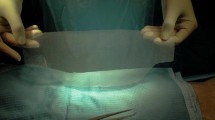Abstract
Background
The need for general anesthesia and the cost and pain due to metal staples required for fixing the mesh are the major reported disadvantages of laparoscopic total extraperitoneal (TEP) hernia repair. We studied the feasibility and results of TEP done under spinal anesthesia with non-fixation of the mesh (SA-NF). This group was compared to TEP done under general anesthesia with non-fixation of the mesh (GA-NF) and repairs done under SA with fixation of the mesh (SA-F).
Methods
A retrospective analysis was carried out in 675 patients (1,289 hernias) in whom TEP was performed. The recurrence rate, pain scores at 24 h and 1 week, hospital stay, days to resume normal activities, seroma formation, and urinary retention rates were noted.
Results
A total of 1,289 TEP repairs (675 patients) were analyzed, with 636 patients (1,220 hernias) in the SA-NF group, 16 patients (27 hernias) in the GA-NF group, and 23 patients (42 hernias) in the SA-F group. Follow up ranged from 13 to 45 months. The recurrence rates, conversion rates, and complications were similar in all three groups. The mean hospital stay, days to resume normal activities, and pain scores were significantly higher in the mesh fixation (SA-F) group.
Conclusions
TEP, done under SA and without fixation of the mesh, is safe, feasible, and associated with low recurrence rates. Since this procedure does not have the disadvantages usually attributed to TEP, it can be possibly recommended as a first-line procedure, even for unilateral inguinal hernias. Further studies are needed to substantiate this.
Similar content being viewed by others
References
Kumar S, Wilson RG, Nixon SJ et al (2002) Chronic pain after laparoscopic and open mesh repair of groin hernia. Br J Surg 89:1476–1479
Memon MA, Cooper NJ, Memon B et al (2003) Meta-analysis of randomized clinical trials comparing open and laparoscopic inguinal hernia repair. Br J Surg 90:1479–1492
Heikkinen TJ, Haukipuro K, Koivukangas P et al (1998) A prospective randomized outcome and cost comparison of totally extraperitoneal endoscopic hernioplasty versus Lichtenstein hernia operation among employed patients. Surg Laparosc Endosc 8:338–344
Liem MS, van der Graaf Y, van Steensel CJ et al (1997) Comparison of conventional anterior surgery and laparoscopic surgery for inguinal-hernia repair. N Engl J Med 336:1541–1547
Johansson B, Hallerbäck B, Glise H et al (1999) Laparoscopic mesh versus open preperitoneal mesh versus conventional technique for inguinal hernia repair: a randomized multicenter trial (SCUR Hernia Repair Study). Ann Surg 230:225–231
Watkin D (2002) Why does NICE not recommend laparoscopic herniorraphy? Patients must consider potential serious complications. BMJ 325:339
Taylor CJ, Wilson T (2005) Long-term results of laparoscopic totally extraperitoneal inguinal herniorrhaphy. ANZ J Surg 75:637–639
Lau H, Patil NG, Yuen WK et al (2003) Prevalence and severity of chronic groin pain after endoscopic totally extraperitoneal inguinal hernioplasty. Surg Endosc 17:1620–1623
Hindmarsh AC, Cheong E, Lewis MP et al (2003) Attendance at a pain clinic with severe chronic pain after open and laparoscopic inguinal hernia repairs. Br J Surg 90:1152–1154
Taylor C, Layani L, Liew V et al (2008) Laparoscopic inguinal hernia repair without mesh fixation, early results of a large randomised clinical trial. Surg Endosc 22:757–762
Ferzli GS, Frezza EE, Pecoraro AM Jr et al (1999) Prospective randomized study of stapled versus unstapled mesh in a laparoscopic preperitoneal inguinal hernia repair. J Am Coll Surg 188:461–465
Moreno-Egea A, Torralba Martínez JA, Morales Cuenca G et al (2004) Randomized clinical trial of fixation vs nonfixation of mesh in total extraperitoneal inguinal hernioplasty. Arch Surg 139:1376–1379
Khajanchee YS, Urbach DR, Swanstrom LL et al (2001) Outcomes of laparoscopic herniorrhaphy without fixation of mesh to the abdominal wall. Surg Endosc 15:1102–1107
Beattie GC, Kumar S, Nixon SJ (2000) Laparoscopic total extraperitoneal hernia repair: mesh fixation is unnecessary. J Laparoendosc Adv Surg Tech A 10:71–73
Spitz JD, Arregui ME (2000) Sutureless laparoscopic extraperitoneal inguinal herniorrhaphy using reusable instruments: two hundred three repairs without recurrence. Surg Laparosc Endosc Percutan Tech 10:24–29
Koch CA, Greenlee SM, Larson DR et al (2006) Randomized prospective study of totally extraperitoneal inguinal hernia repair: fixation versus no fixation of mesh. JSLS 10:457–460
Lal P, Philips P, Saxena KN et al (2007) Laparoscopic total extraperitoneal (TEP) inguinal hernia repair under epidural anesthesia: a detailed evaluation. Surg Endosc 21:595–601
Lau H, Wong C, Chu K et al (2005) Endoscopic totally extraperitoneal inguinal hernioplasty under spinal anesthesia. J Laparoendosc Adv Surg Tech A 15:121–124
Molinelli BM, Tagliavia A, Bernstein D (2006) Total extraperitoneal preperitoneal laparoscopic hernia repair using spinal anesthesia. JSLS 10:341–344
Salihoglu Z, Demiroluk S, Yavuz N (2002) Minimally invasive preperitoneal inguinal hernia repair with epidural anaesthesia. Anaesth Intensive Care 30:813–814
Azurin DJ, Go LS, Cwik JC et al (1996) The efficacy of epidural anesthesia for endoscopic preperitoneal herniorrhaphy: a prospective study. J Laparoendosc Surg 6:369–373
Chowbey PK, Sood J, Vashistha A et al (2003) Extraperitoneal endoscopic groin hernia repair under epidural anesthesia. Surg Laparosc Endosc Percutan Tech 13:185–190
Lau H, Patil NG (2003) Selective non-stapling of mesh during unilateral endoscopic total extraperitoneal inguinal hernioplasty: a case-control study. Arch Surg 138:1352–1355
Koch CA, Grinberg GG, Farley DR (2006) Incidence and risk factors for urinary retention after endoscopic hernia repair. Am J Surg 191:381–385
Mulroy MF (2002) Hernia surgery, anesthetic technique, and urinary retention-apples, oranges, and kumquats? Reg Anesth Pain Med 27:587–589
Tamme C, Scheidbach H, Hampe C et al (2003) Totally extraperitoneal endoscopic inguinal hernia repair (TEP). Surg Endosc 17:190–195
Author information
Authors and Affiliations
Corresponding author
Rights and permissions
About this article
Cite this article
Ismail, M., Garg, P. Laparoscopic inguinal total extraperitoneal hernia repair under spinal anesthesia without mesh fixation in 1,220 hernia repairs. Hernia 13, 115–119 (2009). https://doi.org/10.1007/s10029-008-0442-5
Received:
Accepted:
Published:
Issue Date:
DOI: https://doi.org/10.1007/s10029-008-0442-5




